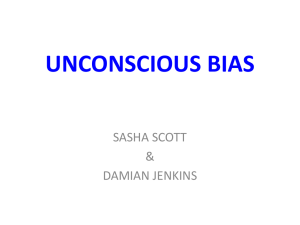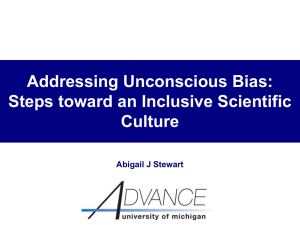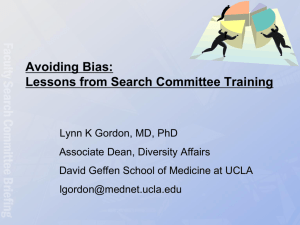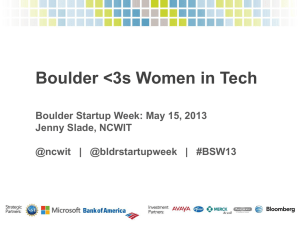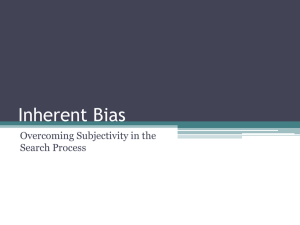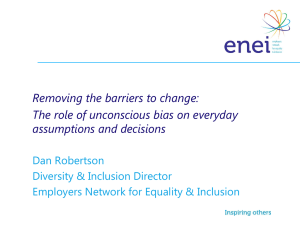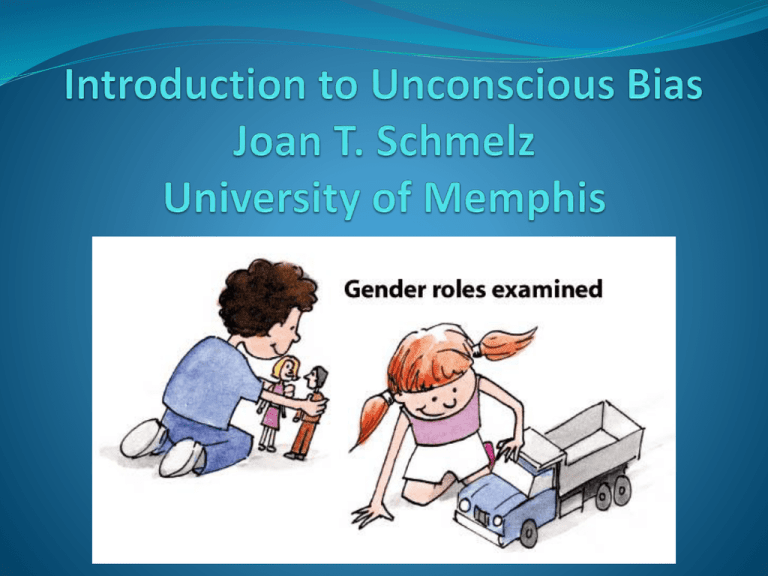
Big Thanks:
-Abigail Stewart (Univ. of Mich.)
-Meg Urry (Yale Univ.)
Slides
References
Information
Plenary Talk for the AAS Winter meeting in Seattle?
Schemas: Non-conscious Hypotheses
Expectations or stereotypes influence our judgments of others
(regardless of our own group).
Gender:
Men judging women; women judging women
Men and women BOTH downplay the contributions of women
Race/ethnicity
Whites judging minorities; minorities judging minorities
Whites and minorities
BOTH downplay the
contributions of
minorities
Unconscious bias is
NOT discrimination
Schemas …
influence group members’ expectations
about how they will be judged.
allow efficient, if sometimes inaccurate,
processing of information.
often conflict with consciously held or
“explicit” attitudes.
change based on experience/exposure.
Nosek, Banaji, & Greenwald (2002). Group Dynamics: Theory, Research and Practice, 6, 101-115.
Fiske, Cuddy, Glick, & Xu (2002). Journal of Personality and Social Psychology, 82(6), 878-902.
Schemas are culturally shared
Both men and
women hold them
about gender.
Both whites and
people of color hold
them about
race/ethnicity.
People are often not
aware of them.
Fiske (2002). Current Directions in Psychological Science, 11, 123-128.
Schemas are applied more often
under circumstances of:
Lack of critical
mass
Time pressure
Stress from
competing tasks
Ambiguity
(including lack of
information)
Fiske (2002). Current Directions in Psychological Science, 11, 123-128.
When Do Schemas Affect
Evaluation Outcomes?
Resumes
Job credentials
Fellowships
Hiring
Awards
Promotion
Unconscious Bias: Gender
Teams of male and female university
psych profs (search committees)
Karen
Evaluate candidates for an open
position (assist prof of psych)
Brian
Application packages for Karen and
Brian are identical except for name
Search committees preferred 2:1 to
hire Brian over Karen
When evaluating a more
experienced record (at the point of
promotion to tenure), reservations
were expressed 4 times more often
when the name was female.
Steinpreis, Anders, & Ritzke (1999) Sex Roles, 41, 509.
Unconscious Bias: Mothers
Mother
When evaluating identical applications:
Evaluators rated mothers as less
competent and committed to paid
work than nonmothers.
Prospective employers called mothers
back about half as often.
Mothers were less likely to be
recommended for hire, promotion,
and management.
Mothers were offered lower starting
salaries.
Active in PTA
“Nonmother”
Correll, Benard and Paik (2007) American Journal of Sociology, 112 (5), 1297-1338.
Unconscious Bias: Fathers
Father
When evaluating identical
applications:
Fathers were not disadvantaged
in the hiring process.
Fathers were seen as more
committed to paid work.
Fathers were offered higher
starting salaries.
Active in PTA
“Nonfather”
Correll, Benard and Paik (2007) American Journal of Sociology, 112 (5), 1297-1338.
Critical Mass Affects Use of Schemas
When there are many
individuals, we
differentiate among
them and cannot rely on
group-based schemas.
In both experimental
and field settings,
increasing the female
share of those being
rated increased ratings
of female applicants and
employees.
Valian (1998) Why So Slow? The Advancement of Women. Cambridge: MIT Press, p. 280;
Heilman (1980) Organizational Behavior and Human Performance, 26: 386-395;
Sackett et al (1991), Journal of Applied Psychology, 76(2): 263-267.
Accumulation of Advantage and
Disadvantage…
Any one slight may seem minor, but
since small imbalances and
disadvantages accrue, they can have
major consequences in
Salary
Promotion
Prestige
Advancement to leadership positions.
“Mountains are molehills piled one on
top of the other.” (Valian, 1998, p. 4)
Merton (1948) Antioch Review, 8, 193-210 and (1968) Science, 159, 56-63.
Valian (1998) Why So Slow? The Advancement of Women. Cambridge: MIT Press, p. 280.
Impact of Schemas on Careers:
Processes for Different Groups Are
Similar
Importance and impact
of schemas
o Lack of critical mass
leads to reliance on
schemas
o Evaluation bias operates
o Accumulation of
disadvantages operates
o
What Can We Do about
Unconscious Bias?
Awareness
Policies
Practices
Accountability
BIAS
Example: Search Committee
How do we start a job search?
0. Recruitment of the Applicant Pool
Form a search committee
2. Write an ad targeting a specific sub-discipline
3. Advertize the position
4. Wait for the applications to pour in
1.
If you follow this standard practice, odds are that the racial and gender
diversity of your applicant pool will look a lot like your current dept. If
you want the pool to be more diverse, you have to work a bit harder.
Recruitment of the Applicant Pool
Recruit proactively year
round
Recruit from wider range
of institutions
Recruit specifically for
underrepresented groups
Use of “open searches”
(broad vs. narrow job
definitions)
If possible, advertize for
multiple positions at once
(cluster hiring).
Active Recruiting
Widen the range of institutions from
which you recruit.
Consider candidates, including women
and minorities, who may currently be
thriving at less well-ranked institutions.
They may be there because of:
Early career decisions based on factors other
than ranking of institution
Past discrimination by top tier
institutions
Candidate’s own internalization of
schemas
Search Committee: Composition Matters
Study of Racial Diversity in Jury Deliberations:
Compared with all-white juries, diverse juries deliberating about an
African American defendant:
Took longer to discuss the case
Mentioned more facts
Made fewer inaccurate statements
Left fewer inaccurate statements uncorrected
Discussed more race-related issues
Jury deliberations are analogous to faculty search deliberations.
Sommers (2006) Journal of Personality and Social Psychology, 90 (4), 597-612.
How do we continue a job search?
Search committee picks ‘best’ candidates
2. Applications sit in a file drawer in chair’s office
3. Faculty invited to browse through the files
4. ‘Best’ candidates are invited to campus
1.
This is the easiest, least painful way to go through this process. Efforts
may be made to avoid conscious bias and prejudice, but opportunities
abound for unconscious bias to dominate the selection.
Candidate Evaluation Tool
http://www.umich.edu/%7Eadvproj/CandidateEvaluationTool.doc
Focus on Multiple Specific Criteria
during Evaluation
Decrease ambiguity of the criteria for the job. Specify
evaluations of scholarly productivity
research funding
teaching ability
fit with the department’s priorities.
Weigh judgments that reflect examination of all
materials and direct contact with the candidate.
Consistent use of evidence
Increase/document knowledge of candidates
Avoid use of global judgments
Bauer and Baltes, 2002, Sex Roles 9/10, 465.
Letters of Recommendation for
Successful Medical School Faculty
Applicants: Differences
Letters for men:
• Longer
• More references to:
• CV
• Publications
• Patients
• Colleagues
Letters for women :
• Shorter
• More references to personal
life
• More “doubt raisers” (hedges,
faint praise, and
irrelevancies)
“It’s amazing how much she’s
accomplished.”
“It appears her health is stable.”
“She is close to my wife.”
Trix & Psenka (2003) Discourse & Society, Vol 14(2): 191-220.
How should we evaluate candidates?
Set criteria before looking at applications
2. Evaluate all applications based on the same criteria
3. All candidates that meet the criteria become part of
the “long short list”
4. All long short list candidates get phone interviews
1.
Excellence has no gender or race or sexual orientation
Speakers
How Did I Get Here? - Role of Unconscious Bias in Career Paths
Patricia Knezek (NOAO/WIYN Consortium, Inc.)
Nibbled to Death by Ducks: The Accumulation of Disadvantage
Caroline E. Simpson (Florida International Univ.)
Actions by Junior Faculty in Addressing Unconscious Bias
Michele Montgomery (Univ. of Central Florida)

